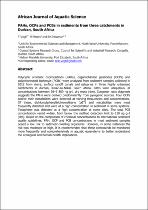JavaScript is disabled for your browser. Some features of this site may not work without it.
- ResearchSpace
- →
- Research Publications/Outputs
- →
- Journal Articles
- →
- View Item
| dc.contributor.author |
Vogt, T

|
|
| dc.contributor.author |
Pieters, R

|
|
| dc.contributor.author |
Newman, Brent K

|
|
| dc.date.accessioned | 2018-10-19T06:03:43Z | |
| dc.date.available | 2018-10-19T06:03:43Z | |
| dc.date.issued | 2018-04 | |
| dc.identifier.citation | Vogt, T., Pieters, R. and Newman, B.K. 2018. PAHs, OCPs and PCBs in sediments from three catchments in Durban, South Africa. African Journal of Aquatic Science, vol 43(1), pp 35-49 | en_US |
| dc.identifier.issn | 1608-5914 | |
| dc.identifier.issn | 1727-9364 | |
| dc.identifier.uri | https://www.tandfonline.com/doi/abs/10.2989/16085914.2018.1445616 | |
| dc.identifier.uri | http://hdl.handle.net/10204/10474 | |
| dc.description | Copyright: 2018 Natl Inquiry Services Centre Pty Ltd. Due to copyright restrictions, the attached PDF file only contains the abstract of the full text item. For access to the full text item, please consult the publisher's website. The definitive version of the work is published in African Journal of Aquatic Science, vol 43(1), pp 35-49 | en_US |
| dc.description.abstract | Polycyclic aromatic hydrocarbons (PAHs), organochlorine pesticides (OCPs) and polychlorinated biphenyls (PCBs) were analysed from sediment samples collected in 2012 from rivers, surface runoff canals and estuaries in three highly urbanised catchments in durban, KwaZulu-Natal, South Africa. PAHs were ubiquitous, at concentrations between 36–6 800 ng g-1 dry mass (dm). Congener ratio diagnosis suggests the PAHs were derived predominantly from pyrogenic sources. Four OCPs and/or their metabolites were detected at varying frequencies and concentrations. Of these, dichlorodiphenyltrichloroethane (ddT) and metabolites were most frequently detected and were at a high concentration in sediment in some systems. Toxaphene was detected at a high concentration at some sites. The total PCB concentration varied widely, from below the method detection limit to 110 ng g-1 (dm). Based on the comparison of chemical concentrations to international sediment quality guidelines, PAH, OCP and PCB concentrations in most sediment samples posed a low risk to sediment-dwelling organisms. However, in some instances the risk was moderate or high. It is recommended that these compounds be monitored more frequently and comprehensively in aquatic ecosystems to better understand the ecological and human health implications. | en_US |
| dc.language.iso | en | en_US |
| dc.publisher | NATL INQUIRY SERVICES CENTRE PTY LTD | en_US |
| dc.relation.ispartofseries | Workflow;20749 | |
| dc.subject | Dichlorodiphenyltrichloroethane | en_US |
| dc.subject | DDT | en_US |
| dc.subject | Organic contaminants | en_US |
| dc.subject | Sediment-dwelling organisms | en_US |
| dc.subject | Sediment quality guidelines | en_US |
| dc.title | PAHs, OCPs and PCBs in sediments from three catchments in Durban, South Africa | en_US |
| dc.type | Article | en_US |
| dc.identifier.apacitation | Vogt, T., Pieters, R., & Newman, B. K. (2018). PAHs, OCPs and PCBs in sediments from three catchments in Durban, South Africa. http://hdl.handle.net/10204/10474 | en_ZA |
| dc.identifier.chicagocitation | Vogt, T, R Pieters, and Brent K Newman "PAHs, OCPs and PCBs in sediments from three catchments in Durban, South Africa." (2018) http://hdl.handle.net/10204/10474 | en_ZA |
| dc.identifier.vancouvercitation | Vogt T, Pieters R, Newman BK. PAHs, OCPs and PCBs in sediments from three catchments in Durban, South Africa. 2018; http://hdl.handle.net/10204/10474. | en_ZA |
| dc.identifier.ris | TY - Article AU - Vogt, T AU - Pieters, R AU - Newman, Brent K AB - Polycyclic aromatic hydrocarbons (PAHs), organochlorine pesticides (OCPs) and polychlorinated biphenyls (PCBs) were analysed from sediment samples collected in 2012 from rivers, surface runoff canals and estuaries in three highly urbanised catchments in durban, KwaZulu-Natal, South Africa. PAHs were ubiquitous, at concentrations between 36–6 800 ng g-1 dry mass (dm). Congener ratio diagnosis suggests the PAHs were derived predominantly from pyrogenic sources. Four OCPs and/or their metabolites were detected at varying frequencies and concentrations. Of these, dichlorodiphenyltrichloroethane (ddT) and metabolites were most frequently detected and were at a high concentration in sediment in some systems. Toxaphene was detected at a high concentration at some sites. The total PCB concentration varied widely, from below the method detection limit to 110 ng g-1 (dm). Based on the comparison of chemical concentrations to international sediment quality guidelines, PAH, OCP and PCB concentrations in most sediment samples posed a low risk to sediment-dwelling organisms. However, in some instances the risk was moderate or high. It is recommended that these compounds be monitored more frequently and comprehensively in aquatic ecosystems to better understand the ecological and human health implications. DA - 2018-04 DB - ResearchSpace DP - CSIR KW - Dichlorodiphenyltrichloroethane KW - DDT KW - Organic contaminants KW - Sediment-dwelling organisms KW - Sediment quality guidelines LK - https://researchspace.csir.co.za PY - 2018 SM - 1608-5914 SM - 1727-9364 T1 - PAHs, OCPs and PCBs in sediments from three catchments in Durban, South Africa TI - PAHs, OCPs and PCBs in sediments from three catchments in Durban, South Africa UR - http://hdl.handle.net/10204/10474 ER - | en_ZA |






